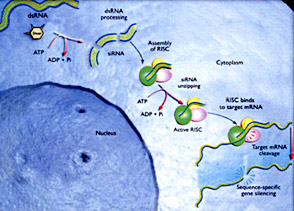More than a Messenger: Discovering the Gene-Regulating Power of Small RNAs and Their Potential as Novel Therapies

Tuschl, Thomas
In the decades after the central dogma of genetics (DNA>mRNA>protein) was formulated, scientists conceived of RNA as a sort of passive information shuttle carrying instructions from the DNA blueprint in a cell's nucleus to the ribosome, where proteins are manufactured. In recent years, however, they have found new forms of RNA that actively regulate gene expression by turning genes off. Rockefeller biochemist Thomas Tuschl (1966 - ) has transformed the field of mammalian genetics by showing how the process—called RNA interference (RNAi)—works in human cells. As a powerful tool for studying gene function, RNAi also has opened the door to developing a new class of therapies for human diseases ranging from viral infections and cancers to metabolic or neurological disorders. Such therapies target misexpressed, disease-causing genes and pre-empt the synthesis of faulty or harmful proteins.
The first breakthrough in RNAi came with a 1998 discovery in studies of the roundworm C. elegans. Andrew Fire, at Stanford University, and Craig Mello, at the University of Massachusetts Medical School, found that long double-stranded RNA (dsRNA) with a sequence homologous to a particular gene can silence that gene. For this discovery Fire and Mello received a Nobel Prize in 2006. Researchers at first thought that RNAi would not work in humans because dsRNAs longer than 30 base pairs, when introduced into mammalian cells, sets off an immune response that destroys them before they can show any gene silencing effect. Then, in 2001, Tuschl made a major advance: he recognized that long dsRNAs were first processed to short dsRNAs, 21-22 base pairs long. He called them small interfering RNAs (siRNAs), because they could turn off genes in mammalian cells by guiding the degradation of the cognate messenger RNA (mRNA) and avoided the immune response specific to longer dsRNAs.
In addition, Tuschl has discovered a naturally occurring class of small RNAs called microRNAs (miRNAs). Found in most organisms and some viruses, miRNAs also regulate protein production by silencing genes. Tuschl's research has identified hundreds of miRNAs and showed that they play important roles in many biological processes, from embryogenesis to cancer. Members of the Tuschl lab are developing miRNA diagnostic tools to evaluate the deregulation of this gene family in disease. Already they have found deregulation of miRNA gene expression in a variety of diseases including cancers or heart failure. Through continuing studies of the biology of RNAi they discovered another class of small RNAs (piRNAs) expressed only in germline cells. Finally, they have also developed powerful new methods to identify the mRNA target sites for small-RNA-containing ribonucleoprotein complexes as well as mRNA-binding proteins to obtain a comprehensive picture of the extent of posttranscriptional regulation in human cells.

Summary of how RNAi works. From RNA Interference: new twist in the RNA world. HHMI
Thomas Tuschl received the PhD from the University of Regensburg, Germany (1995) for research conducted at the Max Planck Institute for Experimental Medicine in Goettingen, Germany, with Fritz Eckstein. He next joined the biology department at the Massachusetts Institute of Technology and the Whitehead Institute for Biomedical Research, where he worked with Phillip A. Sharp and David P. Bartel (1995-1999). Tuschl became a junior investigator at the Max Planck Institute for Biophysical Chemistry (1999-2002) before coming to Rockefeller in 2003 as associate professor. He was promoted to professor in 2009. Tuschl received the European Molecular Biology Organization Young Investigator Award in 2001 and the Biofuture Award from the German government in 1999. He has been a Howard Hughes Medical Institute Investigator since 2005. His achievements have been recognized by the Ernst Jung-Prize for Medicine (2008), the Karl-Heinz-Beckurtz-Prize and the Max Delbrück Medal (2007), the Molecular Bioanalytics Prize, Roche Diagnostics (2006), the Meyenburg Prize (2005), the Irma T. Hirschl Career Scientist Award, and the Ernst Schering Award (2005). In 2003, Tuschl received the Wiley Prize in Biomedical Sciences, the Mayor's Award for Excellence in Science and Technology (New York City), and the Newcomb Cleveland Prize from the American Association for the Advancement of Science.
Selected Publications
Elbashir SM, Lendeckel W, and Tuschl T. RNA interference is mediated by 21- and 22-nucleotide RNAs. Genes Dev, 2001, 15: 188-200
Elbashir SM, Harborth J, Lendeckel W, Yalcin A, Weber K, and Tuschl T. Duplexes of 21-nucleotide RNAs mediate RNA interference in cultured mammalian cells. Nature, 2001, 411: 494-498
Martinez J, Patkaniowska A, Urlaub H, Luhrmann R, and Tuschl T. Single-stranded antisense siRNAs guide target RNA cleavage in RNAi. Cell, 2002, 110: 563-574
Lagos-Quintana M, Rauhut R, Lendeckel W, and Tuschl T. Identification of novel genes coding for small expressed RNAs. Science, 2001, 26: 797-799
Pfeffer S, Zavolan M, Grasser FA, Chien M, Russo JJ, Ju J, John B, Enright AJ, Marks D, Sander C, and Tuschl T. Identification of virus-encoded microRNAs. Science, 2004, 304: 734-736
Kruetzfeld J, Rajewski N, Braich R, Rajeev KG, Tuschl T, Manoharan M, and Stoffel M. Silencing of microRNAs in vivo with 'antagomirs'. Nature, 2005, 438: 685-689
Aravin A, Gaidatzis D, Pfeffer S, Lagos-Quintana M, Landgraf P, Iovino N, Morris P, Brownstein MJ, Kuramochi-Miyagawa S, Nakano T, Chien M, Russo JJ, Ju J, Sheridan R, Sander C, Zavolan M, and Tuschl T. A novel class of small RNAs bind to MILI protein in mouse testes. Nature, 2006, 442: 203-207
Landgraf P, et al. A mammalian microRNA expression atlas based on small RNA library sequencing. Cell, 2007, 129, 1401-1414
Landthaler M, Gaidatzis D, Rothballer A, Chen PY, Soll SJ, Dinic L, Ojo T, Hafner M, Zavolan M, and Tuschl T. Molecular characterization of human Argonaute-containing ribonucleoprotein complexes and their bound target mRNAs. RNA, 2008, 14: 2580-2596
Thum T, Gross C, Fiedler J, Fischer T, Kissler S, Bussen M, Galuppo P, Just S, Rottbauer W, Frantz S, Castoldi M, Soutschek J, Koteliansky V, Rosenwald A, Basson MA, Licht JD, Pena JT, Rouhanifard SH, Muckenthaler MU, Tuschl T, Martin GR, Bauersachs J, and Engelhardt S. MicroRNA-21 contributes to myocardial disease by stimulating MAP kinase signalling in fibroblasts. Nature, 2008, 456: 980-984
Pena JT, Sohn-Lee C, Rouhanifard SH, Ludwig J, Hafner M, Mihailovic A, Lim C, Holoch D, Berninger P, Zavolan M, and Tuschl T. miRNA in situ hybridization in formaldehyde and EDC-fixed tissues. Na. Methods, 2009, 6: 139-141
Further Reading
Farazi TA, Juranek SA and Tuschl T. The growing catalog of small RNAs and their association with distinct Argonaute/Piwi family members. Development, 2008, 135: 1201-1214
Meister G and Tuschl T. Mechanisms of gene silencing by double-stranded RNA. Nature, 2004, 16: 343-349
Dorsett Y and Tuschl T. siRNAs: Applications in functional genomics and potential as therapeutics. Nat Rev Drug Discov, 2004, 3: 318-329
Biology's Big Bang: Unravelling the secrets of RNA. Cover, The Economist, June 16, 2007 edition
Links
Introduction to RNAi by PBS Nova
http://www.pbs.org/wgbh/nova/sciencenow/3210/02.html
Science magazine 2002 Breakthrough of the Year special issue:
http://www.sciencemag.org/content/vol298/issue5602/#special
RNA Interference: A New Twist in the RNA World
http://www.hhmi.org/biointeractive/rna/rnai/index.html?detectflash=false&
